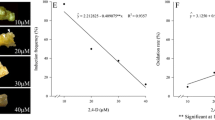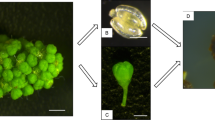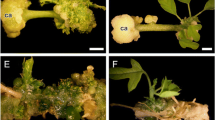Abstract
Segments taken from flower-stalk internodes of Oncidium Sweet Sugar formed somatic embryos and shoot buds directly from wound surfaces or via nodular masses proliferation within 1.5 months, when cultured on a Gelrite-gelled 1/2-MS basal medium supplemented with thidiazuron (0.1–3 mg l−1) in darkness. In light, when subcultured, these nodular masses proliferated into green compact callus, and produced somatic embryos, shoot buds and/or yellowish abnormal structures spontaneously. Supplementing 0.1–1 mg l−1 NAA enhanced embryo formation, but retarded proliferation of shoot buds and yellowish abnormal structures. Somatic embryos that directly formed from wound surfaces of flower stalk explants usually developed into abnormal structures, but the callus-derived embryos could germinate into PLBs and eventually developed to normal plantlets on a hormone-free basal medium for 3–4 weeks. Both the embryo-and shoot bud-derived regenerants developed into healthly plantlets when potted in sphagnum moss and acclimatized in the greenhouse.
Similar content being viewed by others
References
Chang C & Chang WC (1998) Plant regeneration from callus culture of Cymbidium ensifolium var. misericors. Plant Cell Rep. 17: 251–255
Chen JT, Chang C & Chang WC (1999) Direct somatic embryogenesis on leaf explants of Oncidium Gower Ramsey and subsequent plant regeneration. Plant Cell Rep. 19: 143–149
Chen Y & Piluek C (1995) Effects of thidiazuron and N6-benzylaminopurine on shoot regeneration of Phalaenopsis. Plant Growth Regul. 16: 99–101
Dawns CJ (1971) Biological Techniques in Electron Microscopy. Barnes and Noble, New York
Duncan DB (1955) Multiple range and multiple F test. Biometrics 11: 1–42
Ernst R (1994) Effect of thidiazuron on in vitro propagation of Phalaenopsis and Doritaenopsis (Orchidaceae). Plant Cell Tiss. Org. Cult. 39: 273–275
Fast G (1973) Uber einige Methoden zur Vermehrung von Orchideen. Jahresbericht der Fachbochule Weihenstephan (pp 1–5)
Kerbauy GB (1984) In vitro flowering of Oncidium varicosum mericlones (Orchidaceae). Plant Sci. Lett. 35: 73–75
Mok MC, Mok DWS, Armstrong DJ, Shudo K, Isogai Y & Okamoto T (1982) Cytokinin activity of N-phenyl-N'-(1,2,3-thiadiazol-5-yl)-urea (thidiazuron). Phytochemistry 21: 1509–1511
Murashige T & Skoog F (1962) A revised medium for rapid growth and bioassays with tobacco tissue cultures. Physiol. Plant. 15: 495–497
Nayak NR, Rath SP & Patnaik S (1997) In vitro propagation of three ephityic cymbidium, Aloifolium (L.) SW, Dendrobium aphyllu (Roxb) Fisch and Dendrobium moschatum (Buchham) SW through thidiazuron-induced high frequency shoot proliferation. Sci Hort. 71: 416–426
Nuraini I & Shaib JM (1992) Micropropagation of orchids using scape nodes as the explant material. Acta Hortic. 292: 169–172
Teob ES (1989) Orchids of Asia. Times Books International, Singapore
Author information
Authors and Affiliations
Rights and permissions
About this article
Cite this article
Chen, J.T., Chang, W.C. Plant regeneration via embryo and shoot bud formation from flower-stalk explants of Oncidium Sweet Sugar. Plant Cell, Tissue and Organ Culture 62, 95–100 (2000). https://doi.org/10.1023/A:1026591003553
Issue Date:
DOI: https://doi.org/10.1023/A:1026591003553




